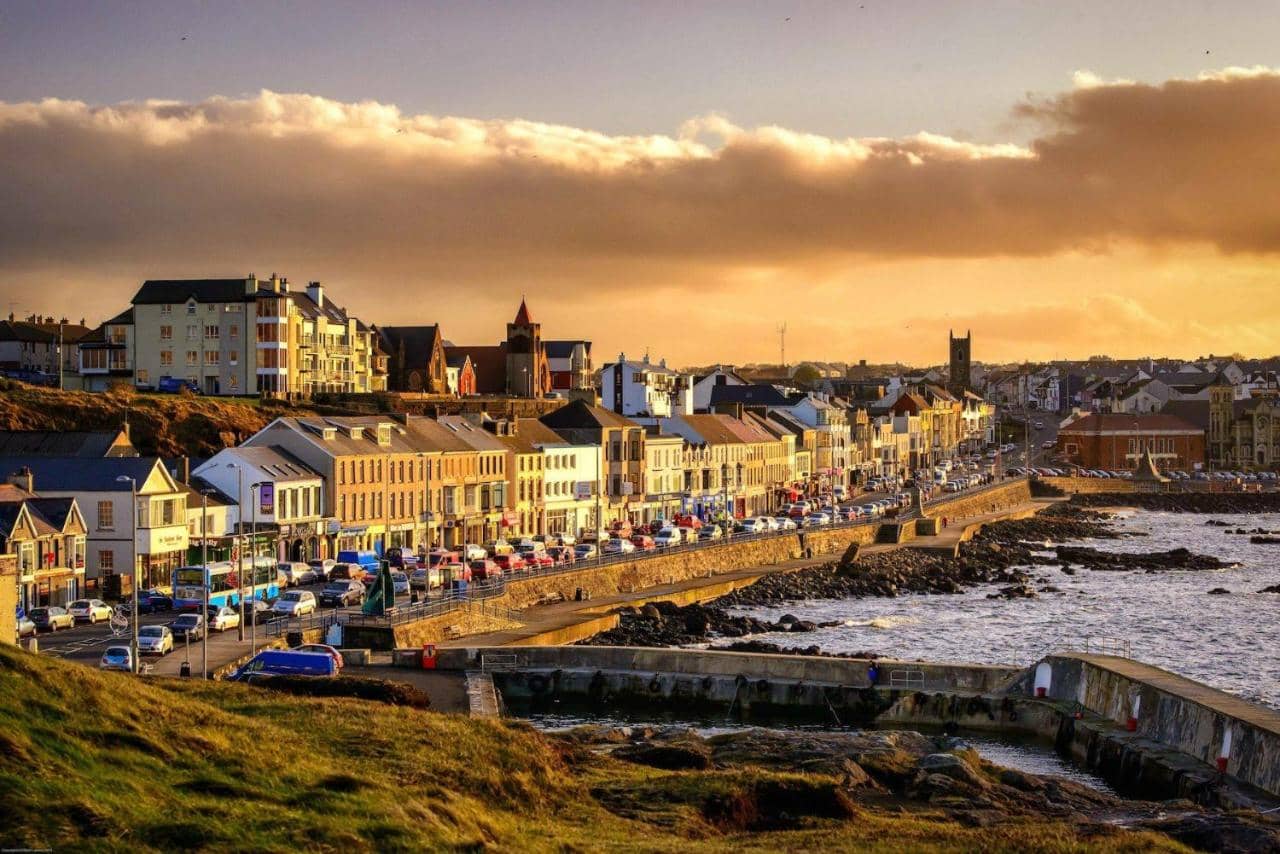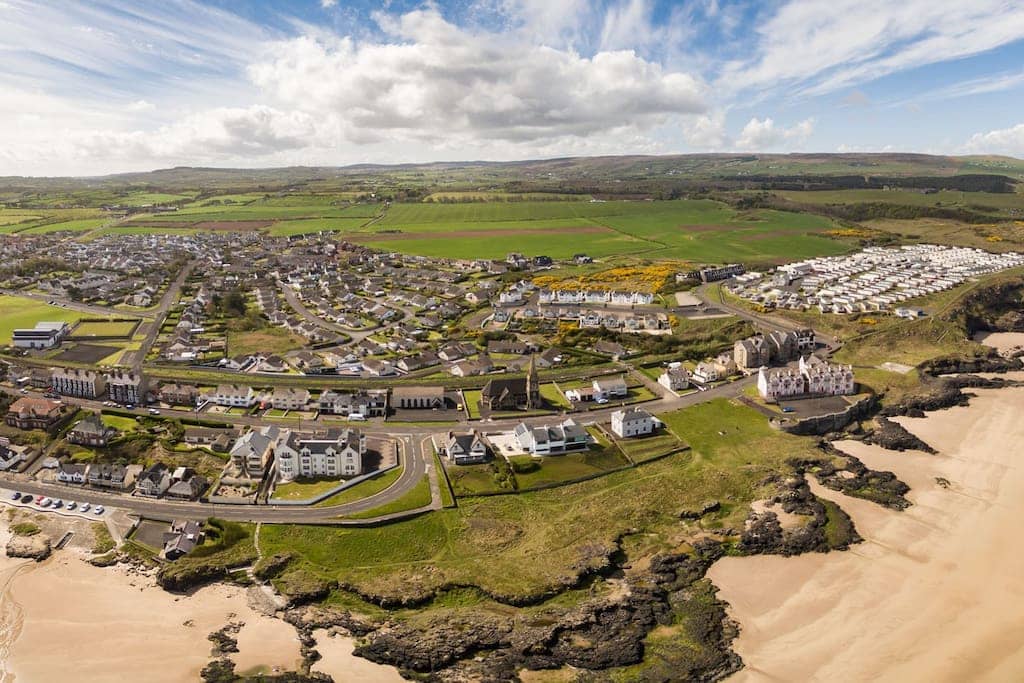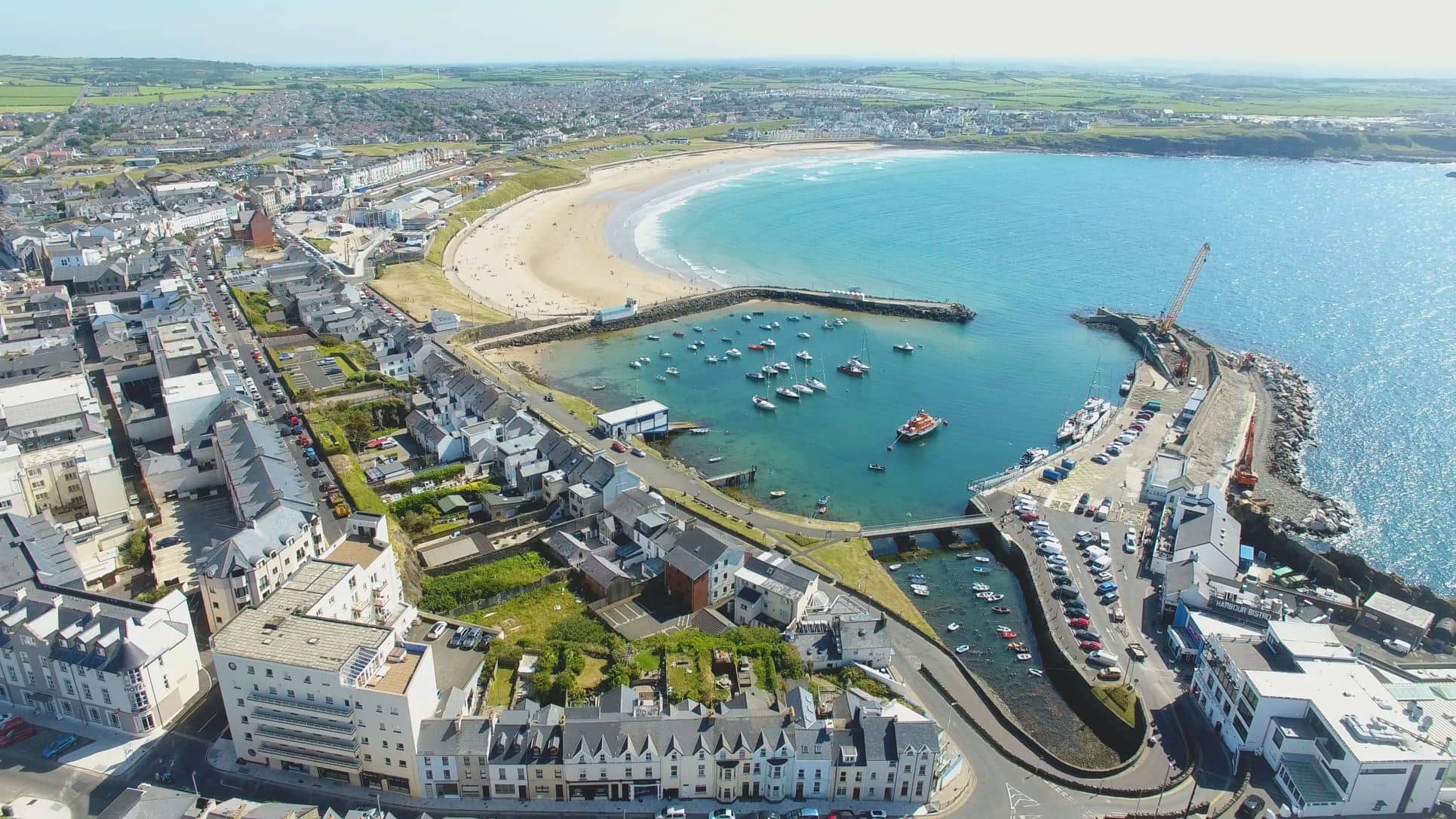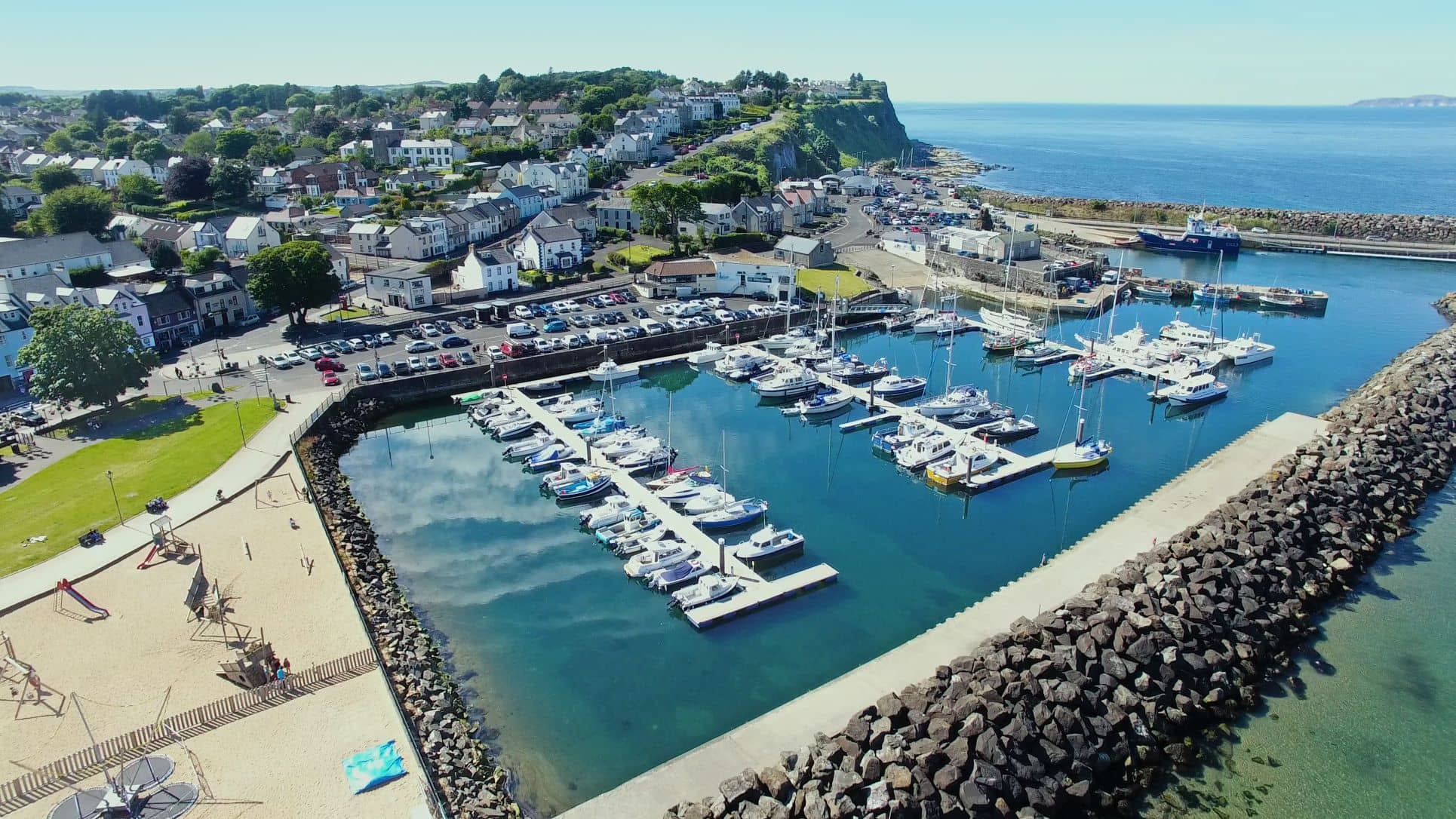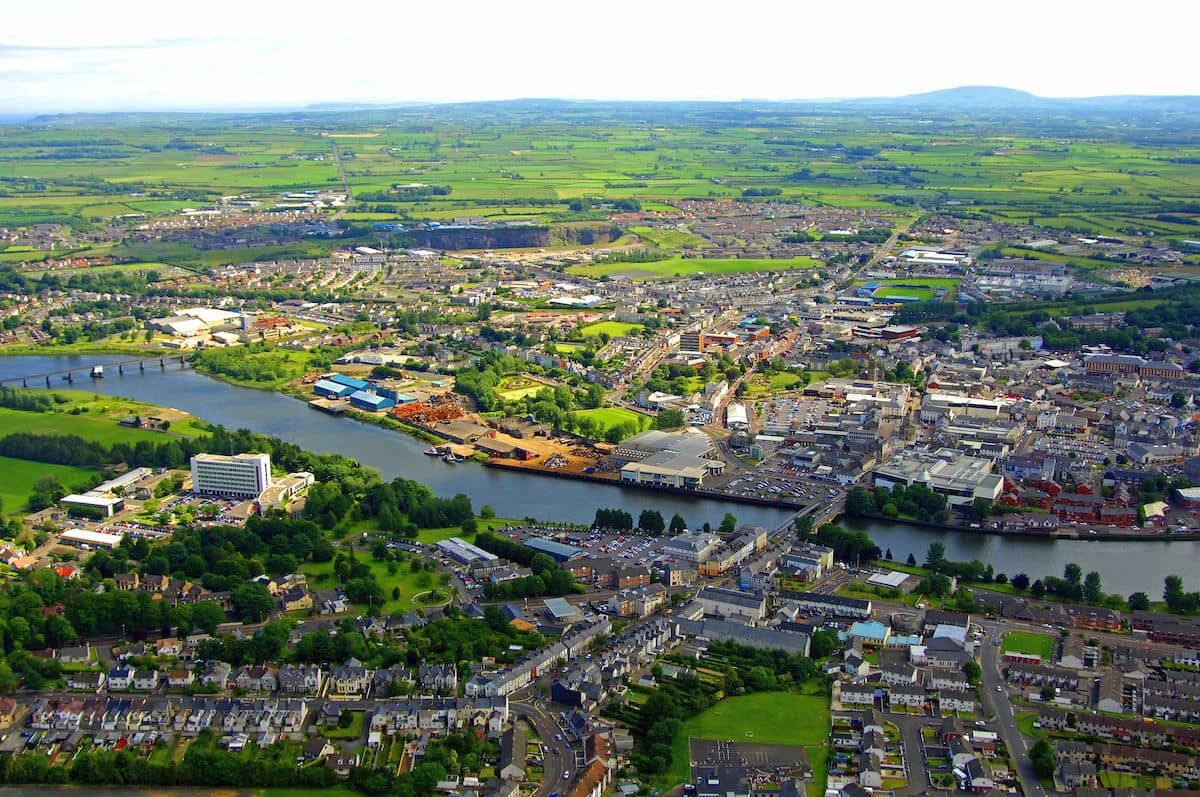A Guide to Portstewart: Discovering the Hidden Gems of Northern Ireland’s Coastal Jewel
Nestled along the rugged shores of Northern Irelands Causeway Coast. A haven for both the adventurer and the solace-seeker, this picturesque town is a must-visit on the Causeway Coast. As the waves crash against the golden sands of Portstewart Strand and the sun sets behind the iconic Dominican College, one can’t help but be captivated by the town’s ethereal beauty. Whether you’re tracing the footsteps of ancient settlers, indulging in local delicacies, getting an ice-cream from Morellis or simply breathing in the salty sea breeze, Portstewart promises an unforgettable experience
Portstewart crescent
Portstewart Crescent is a charming coastal area situated in Northern Ireland, specifically in Portstewart.
Portstewart Promenade
The promenade in Portstewart is a picturesque walkway along the coast of Northern Ireland. Stretching over a two-mile distance, it offers breathtaking views of the North Coast of Northern Ireland.
As you stroll along the promenade, you can appreciate the natural beauty of Portstewart Strand, a stunning beach that attracts visitors from near and far. The golden sands and crashing waves create a serene atmosphere, perfect for a peaceful retreat or a fun-filled day with family and friends. The promenade also provides easy access to other notable attractions in the area, such as the historic Mussenden Temple and the quaint Barmouth, a charming little town offering its own unique charm. Whether you’re taking a leisurely walk or simply enjoying the refreshing sea breeze, the promenade in Portstewart is a delightful spot to explore.
Don’t miss out on the opportunity to explore the promenade in Portstewart during your visit to County Londonderry. It’s the perfect place to soak in the beauty of the coast and immerse yourself in the natural wonders of Northern Ireland. From relaxing beach strolls to admiring the rugged cliffs, the promenade offers a variety of activities for visitors of all ages. So, lace up your walking shoes and discover the wonders that await you along the promenade in Portstewart.
harbour
Nestled on the Causeway Coast of Northern Ireland, the charming seaside town of Portstewart boasts a picturesque harbour that is a must-visit for anyone exploring the area. Situated at the heart of Portstewart, the harbour offers stunning views of the surrounding landscape, including the renowned Portstewart Crescent and the nearby Carrick-a-Rede Rope Bridge. Visitors can take a leisurely stroll along the bustling promenade, lined with quaint shops and cafes, or watch as fishing boats sail in and out of the harbour, their catches of the day bringing life to this vibrant coastal community.
In addition to its idyllic waterfront location, Portstewart Harbour serves as a convenient hub for exploring the wider region. Just a short drive away, visitors can explore the vibrant town centre of Portrush, known for its lively atmosphere and popular attractions such as the Royal Portrush Golf Club. The nearby towns of Coleraine and Londonderry offer further opportunities for exploration, with their rich history and cultural heritage. For those seeking a taste of city life, Belfast is within easy reach, offering a plethora of museums, galleries, and vibrant city streets to wander. With its charming harbour and its strategic location along the coast, Portstewart Harbour is a gateway to an array of exciting experiences along the stunning coast of Northern Ireland.
The Cliff Path
The Cliff Path offers breathtaking views and a serene escape from the hustle and bustle of city life. This picturesque trail winds its way from Portstewart Strand to the charming town of Castlerock, showcasing the natural beauty of the area. As you stroll along the path, you can marvel at the golden sand dunes of Portstewart Strand on one side and the majestic cliffs on the other. The Cliff Path is a hidden gem that is perfect for nature lovers and outdoor enthusiasts alike.
The Cliff Path provides a unique opportunity to explore the stunning coastline and immerse yourself in the rich history of the area. Along the trail, you will discover remnants of ancient castles and fortifications, adding a touch of intrigue to your journey. As you make your way closer to Castlerock, the path meanders through lush green fields and panoramic vistas, offering a true sense of tranquility. Whether you’re an avid hiker or simply looking for a leisurely stroll, The Cliff Path is an experience not to be missed during your visit to Portstewart.
Portstewart strand
The Portstewart Strand is one of Portstewart’s most beloved attractions. Located on the coast of Northern Ireland, this stunning stretch of beach captivates visitors with its golden sands and breathtaking views of the North Coast. Whether you’re a local resident or a tourist visiting Portstewart, a leisurely stroll along the Portstewart Strand is an absolute must.
One of the best ways to enjoy the Portstewart Strand is by taking a walk along the nearby Cliff Path. This scenic route provides a mesmerizing panorama of the coastline, offering glimpses of the rugged cliffs and crashing waves. As you make your way along the path, you’ll also have the opportunity to explore some hidden gems, such as O’Hara’s Castle, which is nestled on the cliffside.
The Portstewart Strand has something to offer year-round. During the warmer months, it’s the ideal spot for sunbathing, picnicking, or even trying your hand at water sports. The beach’s close proximity to the town center of Portstewart means you can easily grab a refreshing ice cream cone from one of the parlors on the bustling Portstewart Promenade before settling down on the sand. And even in the cooler months, the Portstewart Strand remains a captivating destination, with its tranquil atmosphere and the opportunity to take long, peaceful walks along the vast shoreline.
As one of Northern Ireland’s designated Areas of Outstanding Natural Beauty, the Portstewart Strand is a true gem of the region. Its pristine sand is one of Northern Ireland’s greatest assets, attracting visitors from near and far. Moreover, the beach is protected by the National Trust, ensuring its preservation for generations to come. So whether you’re a nature lover, a beach enthusiast, or simply seeking a relaxing environment to unwind, the Portstewart Strand is a destination not to be missed.
Portstewart Golf Club
Parks in Portstewart
Portstewart, a beautiful seaside town located on the stunning Lough Foyle, is home to several parks that offer visitors a chance to relax and enjoy the natural beauty of the area. With its proximity to golf courses and its recognition by the Northern Ireland Tourist Board, Portstewart is a haven for nature lovers.
One of the most popular parks in Portstewart is the Portstewart Strand, which holds the prestigious Blue Flag for its inclusive beach. It is one of the finest beaches in Ireland where cars are still allowed, making it convenient for visitors to explore the coastline. The strand’s golden sands stretch for miles, providing ample space for relaxation and beach activities. Additionally, the beach offers stunning views of the surrounding coastline, creating a picturesque setting for a leisurely stroll.
Portstewart also has many places where visitors can unwind amidst nature. From the tranquil Portstewart Crescent to the scenic grounds of Dominican College, there are plenty of green spaces for families and individuals to enjoy. Whether you prefer a peaceful picnic or a brisk walk, these parks provide an opportunity to escape the hustle and bustle of daily life and immerse yourself in the serene atmosphere of Portstewart.
From its prestigious Blue Flag beach to its charming parks, Portstewart offers a variety of options for outdoor enjoyment. Whether you are seeking relaxation or adventure, this seaside town has something for everyone to enjoy. So, when visiting Portstewart, be sure to take the time to explore these beautiful parks and immerse yourself in the natural splendor of this breathtaking coastal destination.
Where are the best places to eat in Portstewart
Portstewart is home to a variety of dining establishments that offer delectable cuisine combined with stunning views. For those seeking panoramic views, there are several options along the scenic coastal area. One notable spot is the promenade, which is lined with restaurants and cafes offering breathtaking vistas of the sea. Another must-visit is the harbor, where diners can savor their meal while enjoying the picturesque sight of boats bobbing in the water. For history buffs, a visit to O’Hara’s Castle is a must. This charming restaurant, built in 1834, not only serves delicious food but also provides a glimpse into Portstewart’s rich heritage.
If you’re in the mood for a day trip to explore the surrounding areas, Portstewart’s ideal location between Portrush and Coleraine makes it a convenient starting point. Just outside Portstewart lies the famous Portstewart Strand, where visitors can take a leisurely stroll along miles of golden sandy beaches. National Trust members can also enjoy access to Downhill Beach and Castlerock Beach, both situated within a short distance from Portstewart. Additionally, the nearby Carrick-a-Rede Rope Bridge and the Pleasure Beach in Portrush offer exciting attractions for a fun-filled day trip. When the sun sets, Portstewart’s nightlife scene comes alive, with various pubs and bars offering a vibrant atmosphere for those looking to unwind and enjoy the local entertainment.
As you explore the mouth of Portstewart and the greater island of Ireland, rest assured that there are numerous culinary delights waiting to be discovered. From restaurants offering breathtaking views to those steeped in history, Portstewart boasts a diverse dining scene that caters to all tastes. Whether you’re a local resident or a visitor, the gastronomic options in this charming coastal town are sure to leave a lasting impression. So, hop in your car or set off on foot to explore the best places to eat in Portstewart and indulge in a truly memorable dining experience.
Where to stay while visiting Portstewart
Portstewart is a popular holiday destination in Northern Ireland, known for its beautiful coastline and important natural attractions. The town offers a range of accommodation options for visitors looking to stay and fully enjoy all that Portstewart has to offer.
When it comes to finding a place to stay in Portstewart, one of the town’s highlights is its proximity to the stunning Portstewart Strand. This blue flag beach is considered one of Northern Ireland’s finest, with its long stretch of golden sand and crystal-clear waters. It’s important to note that cars must leave the beach by a certain time, as the beach will be closed to vehicles during the day. Along the beach, there are facilities for beach equipment loan, allowing visitors to make the most of their time on the sand. Additionally, staying close to the beach offers the convenience of being just a short distance from the town centre, where visitors can find a variety of restaurants, shops, and entertainment options, including the vibrant Aura Nightclub.
Portstewart provides a range of accommodation choices, catering to different preferences and budgets. Whether you’re seeking a luxury hotel experience or a cozy bed and breakfast, there are options to suit every traveler. Many of the accommodations in Portstewart boast stunning views of the coast and offer a comfortable and welcoming atmosphere. With its simply amazing surroundings and one of Northern Ireland’s finest beaches, staying in Portstewart ensures a memorable and enjoyable visit to this charming seaside town.
Nearby Places
Just a short distance from Portstewart, visitors can find a variety of nearby places that offer something for everyone. For those seeking some excitement and entertainment, the Havana Night Club is a popular destination. With its vibrant atmosphere and lively music, it is the perfect spot to dance the night away.
Nature enthusiasts will be delighted to discover the golden sand beach nearby. With its stunning views and crystal-clear waters, this beach is a haven for beachgoers, especially during the high season. Whether you prefer to relax on the sun-kissed sand or participate in various beach-related activities, this spectacular beach has it all.
Golf enthusiasts will rejoice, as numerous golf clubs are situated in the vicinity. These clubs provide excellent facilities and well-maintained courses, ensuring a memorable game for players of all skill levels. Additionally, some of these golf courses offer breathtaking views, nestled on the edge of a cliff, creating a unique and picturesque setting.
